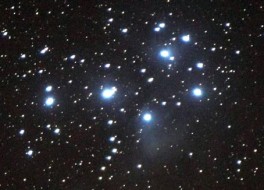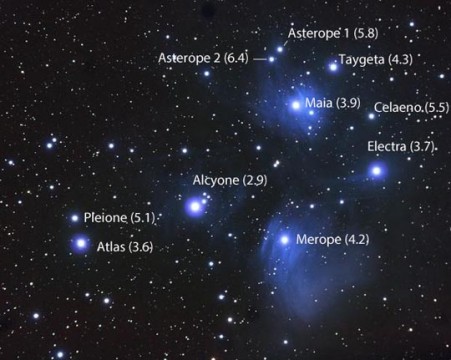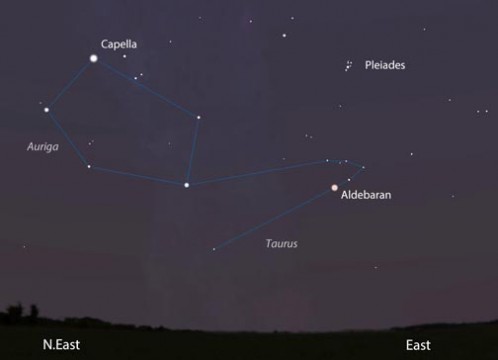 |
Canku Ota
|
 |
|
(Many Paths)
|
||
|
An Online Newsletter
Celebrating Native America
|
||
|
August 2016 - Volume
14 Number 8
|
||
|
|
||
|
How Many Pleiades
Can YOU See?
|
||
|
by Bob King - Sky &
Telescope Media
|
||
|
Most of us are familiar with the Seven Sisters, but have you met their brothers? Learn how to find more Pleiades than first meet the eye.
They're called the Seven Sisters, but can you see all seven? Better known as the Pleiades star cluster, this lovely group in the shape of a miniature Big Dipper enchants the eye on autumn nights. I love watching the Pleiades. There’s nothing quite like it in the heavens. Most stars are single and separate from each other, but the Pleiades packs more than a handful into a compact bunch that stands apart from nearly everything else in the sky. The Pleiades is one of brightest star clusters in the sky. It contains some 3,000 stars and lies about 444 light-years from Earth. Side to side the group spans 13 light-years, or about halfway from Earth to the bright star Vega. Like a school of fish, its members move together as a gravitationally-bound swarm through space. In late October the group clears the treetops around 9:30 p.m. local time and remains visible the rest of the night.
When asked how many stars they see in the cluster, beginning observers will usually say five. That's what most of us see at a glance, and it makes sense because the five brightest Pleiades — Alcyone, Atlas, Electra, Maia, and Merope — range from magnitude 2.9 to 4.2, well within the grasp of most observers from a reasonably dark sky site. But can we do better?
According to Agnes Clerke, a late 19th-century/early 20th-century astronomer and writer: "Carrington and Denning (British amateur astronomers) counted fourteen." Robert Burnham, in his 3-volume Celestial Handbook, writes that "there are at least 20 stars in the group which might be glimpsed under the finest conditions." Wow! Really? Let's start with the next two easier targets. Extend a line from Alcyone through Maia to find Taygeta. Most amateur astronomers can spot this one with ease. A touch of averted vision, a technique of looking "around" the object of interest instead of directly at it, should make this a snap. It's the next one, Pleione, that gives many observers trouble. Not only is it dimmer, but the star nestles against brighter Atlas. For me, seeing it requires good dark adaption, patience, and a mix of averted and direct vision.
That's seven. Ready to move on to the challenge round? We now go deep, pinging stars ranging from magnitude 5.4 to the inky sky limit of 6.5. Fully dark-adapted eyes and a moonless, transparent sky are musts. The dim Asterope duo and Celaeno beckon near the Pleiades core, but that's the problem. They're so close to other member stars, they're difficult to distinguish on their own. I've caught tantalizing hints of both with averted vision when the cluster's high in the sky. Asterope presents a special challenge as the pair is separated by only 2.4 arc minutes — more than one arc minute closer than the famous Double-Double Epsilon Lyrae, itself no easy split, and nearly two magnitudes fainter. At best, you might see them as a single elongated star. Once we move beyond the distraction of the central cluster, hunting gets easier. The magnitude 5.4 star (HD 23753) below the "dipper handle" is relatively easy, but the 6.0 (HD 23950) will place greater demands on your visual cortex. 18 Tauri likewise is relatively easy with averted vision, but beware of the 6.1 and 6.5 members south of Atlas. They'll push your vision to the limit. But that's where you want to be, right? Limits tempt us to go that extra step.
By the way, I keep a pair of binoculars at my side to not only verify Pleiades star sightings, but to help me know just where to look if I'm having difficulty finding a star. They also provide a splendid and visually refreshing look at the cluster after straining to see its fainter members. So let's add up our starry gems. The bright five plus two not-so-difficult core cluster stars make seven. Add in seven more faint hanger-ons (we'll count Asterope as one) and you've got 14. Not bad, not bad at all.
|
||||||||||
|
|
||
|
|
||
| Canku Ota is a free Newsletter celebrating Native America, its traditions and accomplishments . We do not provide subscriber or visitor names to anyone. Some articles presented in Canku Ota may contain copyright material. We have received appropriate permissions for republishing any articles. Material appearing here is distributed without profit or monetary gain to those who have expressed an interest. This is in accordance with Title 17 U.S.C. Section 107. | ||
|
Canku Ota is a copyright ©
2000 - 2016 of Vicki Williams Barry and Paul Barry.
|
||
 |
 |
|
|
The "Canku
Ota - A Newsletter Celebrating Native America" web site and
its design is the
|
||
|
Copyright ©
1999 - 2016 of Paul C. Barry.
|
||
|
All Rights Reserved.
|
||




